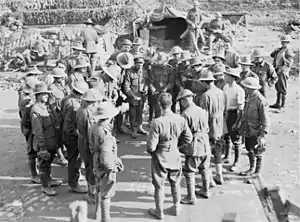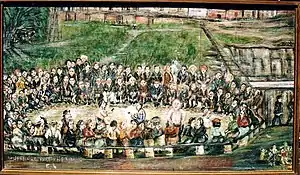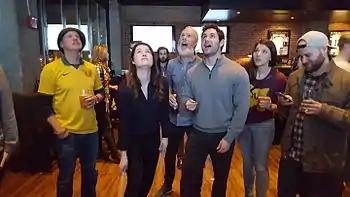



Two-up is a traditional Australian gambling game, involving a designated "spinner" throwing two coins, usually Australian pennies, into the air. Players bet on whether the coins will both fall with heads (obverse) up, both with tails (reverse) up, or with a head and one a tail (known as "Ewan"). The game is traditionally played in pubs and clubs throughout Australia on Anzac Day, in part to mark a shared experience with diggers (soldiers).
The game is traditionally played with pennies, because their weight, size, and surface design make them ideal for the game. Weight and size make them stable on the "kip" and easy to spin in the air. Decimal coins are generally considered to be too small and light and do not fly as well. The design of pre-1939 pennies had the sovereign's head on the obverse (front) and the reverse was totally covered in writing, making the result very easy and quick to see. However, pennies used in the game are usually now marked with a white cross on the tails side. Pennies being used at games on Anzac Day are brought out specifically for that purpose each year.
History
The exact origins of two-up are obscure, but it seems to have evolved from cross and pile, a gambling game involving tossing a single coin into the air and wagering on the result. Two-up was popular amongst poorer English and Irish citizens in the 18th century.
The predilection of the convicts for this game was noted as early as 1798 by New South Wales's first judge advocate, as well as the lack of skill involved and the large losses. By the 1850s, the two-coin form was being played on the goldfields of the eastern colonies, and it spread across the country following subsequent gold rushes.
Two-up was played extensively by Australia's soldiers during World War I. Gambling games, to which a blind eye was cast, became a regular part of Anzac Day celebrations for returned soldiers, although two-up was illegal at all other times.
As time passed, increasingly elaborate illegal "two-up schools" grew around Australia, to the consternation of authorities but with the backing of corrupt police. The legendary Thommo's Two-up School, which operated at various locations in Surry Hills, Sydney, from the early years of the 20th century until at least 1979, was one of Australia's first major illegal gambling operations.[1]
The popularity of two-up declined after the 1950s as more sophisticated forms of gambling like baccarat gained popularity in illegal gaming houses as well as when poker machines (slot machines) were legalised in clubs.
Legal two-up arrived with its introduction as a table game at the new casino in Hobart in 1973, but is now only offered at Crown Perth and Crown Melbourne. Two-up has also been legalised on Anzac Day, when it is played in Returned Servicemen's League (RSL) clubs and hotels. Several tourist "two-up schools" in the Outback have also been legalised. Under the NSW Gambling (Two-Up) Act 1998, playing two-up in NSW is not unlawful on Anzac Day.[2]
| Term | Meaning |
|---|---|
| School | The collective noun for a group of gamblers playing two-up. |
| Ring | The area designated for the spinner to spin the coins. The spinner must stand in the ring to spin, and the coins must land and come to rest within the ring. |
| Spinner | The person who throws the coins up in the air. The opportunity to be the spinner is offered in turn to gamblers in the school. |
| Boxer | Person who manages the game, usually provides the equipment, monitors the betting, takes commission and does not participate in betting. |
| Ringkeeper (Ringie) | Person who calls the validity of each throw and looks after the coins between throws, to avoid loss or interference. Places the coins on the kip for the spinner when the betting round is complete, and calls "Come in, Spinner" to allow the throw to take place. Sometimes also known as the "Bender", for bending down to retrieve the coins. |
| Kip | A small piece of wood on which the coins are placed before being tossed. Sometimes the resting area for the coins is covered in canvas or leather to improve friction. In some games, coins are placed tails (white cross) up. In casino games the coins are placed with opposing (one head, one tail) sides up. |
| Toss the Kip | The Spinner hands the kip back to the Ringkeeper before a possibly losing throw, i.e. to retire after a winning throw. |
| Heads | Both coins land with the "head" side facing up. (Probability 25% (approximately)[4]) |
| Tails | Both coins land with the "tails" side facing up. (Probability 25%) |
| Odds or "One Them" | One coin lands with the "head" side up, and the other lands with the "tails" side up. (Probability 50%) |
| Odding Out | To spin five "odds" in a row. (Probability 3.125%) |
| Come in, Spinner | The call given by the boxer when all bets are placed and the coins are now ready to be tossed. |
| "Barred" | The call when an illegal spin has occurred - the coins have not been thrown higher than the head, or did not rotate in the air. |
| Cockatoo | A look-out who warns players of imminent police raids. Dates from the time when playing two-up was illegal. |
The table below show the current bets that can be made at Crown Perth.
| Bet Type | Casino Edge | Payout | Description |
|---|---|---|---|
| Single Head | 3.125% | 1–1 | Spinner spins a pair of heads before a pair of tails or odding out. |
| Single Tail | 3.125% | 1–1 | Spinner spins a pair of tails before a pair of heads or odding out. |
| 5 Odds | 9.375% | 28–1 | Spinner spins five odds in a row ("odding out") before either a pair of heads or a pair of tails. |
| Spinner's Bet | 3.400% | 15–2 | Only available to the current spinner. The spinner attempts to spin either three pair of heads or three pair of tails, and will win if they do so before either a) getting the opposite result or b) odding out.[3] |
Gameplay

The Ringie selects a player as the spinner (generally greeted to loud calls of "Come in, Spinner!" from the rest of the players). The spinner tosses the coins in the air using the kip until they win (and continue spinning), lose (and the kip is offered to the next player around the ring), or toss the kip (take their winning wagers and retire).
The basic format of the game:
- Two heads means the spinner wins.
- Two tails means the spinner loses both their bet, and the right to spin.
- Odds ("one them") means head or tail bets are frozen, and the spinner throws again.
The spinner is required to place a bet (usually on heads) before their first throw which must be covered (equaled) by another player. If the spinner wins they keep the bet and cover, minus a commission which the boxer takes out of this bet. If the spinner loses, the entire bet goes to the player who covered the bet. This makes throwing the coins a slight losing proposition compared to a side bet, however this is balanced by the interest of throwing the coins and the chance of adding a personal "lucky" touch to the spin. The disadvantage (cost of running the game) is shared about the School by the Kip being passed about the Ring during subsequent spins.[5]
As a betting round and subsequent spin takes about a minute, and is resolved win/loss on average every three spins, then the Boxer's commission on wins is paid on average ten times per hour. i.e. If the Spinners' average wager is $20, covered by $20, and the commission is 10% then the Boxer will take $40 an hour in commission. The taking of commission has been made illegal for unlicensed games in most states, even when play is permitted (e.g. Anzac Day).
The other members of the school place side bets (bets against each other) on whether the coins will Head or Tail. These bets are offered by shouting the amount and preference (i.e. "Fifty dollars head!) perhaps while tapping the money on their head, until another player who wishes to bet on the opposite coin approaches them to cover the bet. The combined amount of the bet is traditionally held by the tail-better until the bet resolves (i.e. Heads is thrown, and the combined bet is handed over to the head-better, or Tails is thrown and the combined bet is pocketed by the tail-better.) This usually results in the heavier/wealthier betters taking the "tails" bet, allowing them to cover a number of "heads" bets on each throw.
Variations
Some variations include:
- Throwing three coins, instead of two: As at least two coins will always match, this results in a decision on every throw (two heads or two tails, with the third coin being redundant - "sudden death"), and thus a faster game, with more action, as the bets are resolved on every throw - there is no pause in gambling when odds are thrown.
- The spinner only wins after a successive run of heads: I.e., if three heads are required before a tails, with any number of odds, then "odds, heads, odds, odds, heads, odds, heads" would be a win. Casinos pay this at 7.5 to 1. This speeds up play as the Spinner can't "Toss the Kip" after a single throw (selecting a new spinner takes time, interrupting play).
- If the spinner throws successive odds they lose: I.e., if five odds thrown before a tails loses while three heads are required to win, then "odds, heads, odds, odds, heads, odds, odds" would be a loss. Casinos use this rule to provide them with the edge they need to run the game, as the Casino collects all Head/Tail bets if five odds in a row are thrown.
- In Casino games the Spinner may bet on either heads or tails.
- In Casinos, no side bets are permitted; all bets are placed with the Casino as bank.
- Two Up game has been used to develop a quantum game called Quantum Two Up [6] in which the coins are entangled. To win the game, one has to discover the law of entanglement that favors a particular coin combination.
Popular culture
On 17 November 2004, the Premier of New South Wales remarked in the New South Wales Legislative Assembly:
One of the charities most involved in problem gambling, the Wesley Community Legal Service, a body dealing with problem gamblers, has confirmed it has never encountered a problem gambler addicted to two-up. That is an interesting bit of trivia for everyone to take home with them.
In 1978, the Australian group Little River Band released their fourth album Sleeper Catcher, which featured the band and others on the cover playing the game. In the liner notes it says:
Sometimes called "Australia's National Game", two-up is a form of gambling which, though illegal, has long been a favourite pastime. The "Sleeper Catcher", an accepted participant in the game, retrieves bets left on the floor by tardy backers.
The protagonist of C. J. Dennis' 1915 verse novel The Songs of a Sentimental Bloke suffers from an addiction to playing two-up.
The Australian rock group AC/DC has a song called "Two's Up" on their 1988 Blow Up Your Video album that references the game.
In the 1960 film Hell Is a City set in Manchester, England,[8] there is a scene in which robbers use stolen money to join in a gang of local men gathered on a hill behind the town to gamble "the toss". A thrower balances two pennies on two outstretched fingers and then tosses them high in the air to see how they land. The thrower wins with double heads and loses with double tails. Other men in the crowd cover his bets (bet against him), with a "boxer" handling the money and keeping track of the bets. Lookout men with binoculars and whistles sat by upper windows of nearby buildings to warn of police arriving.[9]
The film The Sundowners contains a sequence in which a group of Australian drovers, including Robert Mitchum's character, play a game of two-up, with appropriate bets. One of the players calls out "fair go", which translates roughly as "play fair". Appropriately, the action in the game on-screen is rapid and without hesitations or false starts. In the 1940 film Forty Thousand Horsemen, the three leads, played by Grant Taylor, Chips Rafferty, and Pat Twohill, are introduced to us playing two-up in a market place.[10]
The 1971 film Wake in Fright contains scenes where the main protagonist, a schoolteacher named John Grant, staying in a semi fictional mining town based on Broken Hill for one night, initially makes significant winnings in a game of two-up, before subsequently losing everything again.
The book Come In Spinner takes its name from the call. There is also a sequence in the film The Shiralee starring Bryan Brown which makes reference to the game.
During the broadcast recording of the 'Tin Symphony' segment of the opening ceremony of the 2000 Olympic Games there are two scenes of settlers playing two-up outside a tin home.[11]
The Australian-themed 2002 video game Ty the Tasmanian Tiger features a tutorial area named "Two-Up".
In 2009, the television program Underbelly: A Tale of Two Cities shows men taking part in games of two-up. In one instance the police enter the establishment in which this is taking place and the contestants run and hide the equipment being used and money being gambled.
In 2014, the television program Peaky Blinders depicts a game of two-up, with a car and a horse used for betting.
On 20 February 2015, a game of two-up featured in The Doctor Blake Mysteries, series 3, episode 2, titled "My Brother's Keeper".
Notes
- ↑ Hickie, David. The Prince and The Premier, p. 155
- ↑ "Gambling (Two-up) Act 1998". New South Wales Consolidated Acts.
- 1 2 "Two Up" (PDF). Liquor & Gaming NSW. 17 August 2016. Retrieved 9 November 2020 – via star.com.au.
- ↑ P. Diaconis et al "Dynamical Bias In The Coin Toss" (PDF).
- ↑ A.W. Jose; et al., eds. (1926). The Australian Encyclopaedia Vol. II. Sydney: Angus & Robertson. pp. 600–601.
- ↑ https://play.google.com/store/apps/details?id=com.QuantumGamesLLC.QuantumTwoUp
- ↑ "Two-up". New South Wales Parliament. 17 November 2004.
- ↑ "Hell Is a City (1960)". IMDb. Retrieved 9 November 2020.
- ↑ Archived at Ghostarchive and the Wayback Machine: "Hell is a City (1960) - the tossing ring". Retrieved 9 November 2020 – via YouTube.
- ↑ Van-Dyk, Robyn (21 December 2006). "Forty Thousand Horsemen". Australian War Memorial. Australian War Memorial. Retrieved 28 December 2014.
- ↑ The Opening Ceremony of the 2000 Olympic Games A Sydney Celebration (DVD) (revised ed.). Warner Vision Australia. 2000. 73.05 minutes in. 8573857422.
References
- Australian gambling – Comparative history and analysis- report published by the Victorian Casino and Gaming Authority
External links
- Description of two-up as played by 2/12th Commando Squadron Australian War Memorial
- History of the two-up set used by NX203594 Private Milton George Heuston, 2/12 Commando Squadron Australian War Memorial
- Newspaper report of a police raid on an illegal two-up school (Adelaide Advertiser 12 December 1931, page 17).